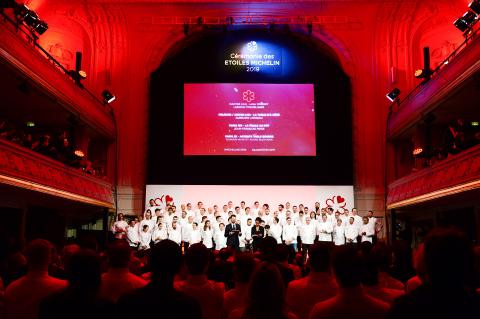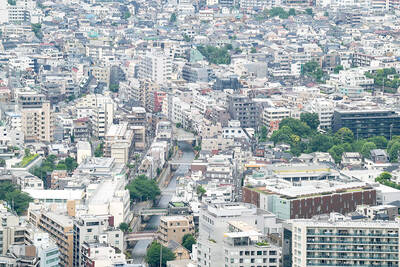The Michelin Guide to fine dining, which unveiled its 2019 edition on Monday, began recommending restaurants in France a century ago before branching out to become one of the most competitive international guides of its kind.
Here is some background.
BORN ON THE ROAD

Photo: EPA-EFE
The red-covered guide is published by the French tire manufacturer of the same name, its tire-man mascot on the cover giving a hint of its origins. It was first published in France in 1900 when there were fewer than 3,000 automobiles on the roads but the prospects for car travel were promising.
To encourage motorists to take to the road and so boost their tire-manufacturing business, brothers Andre and Edouard Michelin decided to print a travel guide.
At first distributed for free, it included maps, a how-to on changing tires, and lists of mechanics and hotels along the route. The first run of 35,000 copies was such a success that guides for Belgium, Germany, Portugal and Spain followed.
COVETED STARS
Michelin introduced restaurant listings in 1920, when it started charging for the guide, later sending out undercover inspectors. In the early 1930s came the ratings via a star hierarchy that developed into the highly competitive and coveted formula for which the guide is perhaps best known today.
One star indicates “A very good restaurant in its category;” two stars is for “Excellent cooking, worth a detour;” and three rates “Exceptional cuisine, worth a special journey.”
Since 1997 Michelin has also awarded a “Bib Gourmand” which is not a star but designates an eatery offering excellent food at moderate prices.
Of about 20,000 international restaurants listed, only around 100 have attained the highest distinction.
MICHELIN GOES GLOBAL
In 2005 the Michelin Guide left Europe with its New York guide, followed in 2007 by editions for San Francisco then Las Vegas and Los Angeles.
It branched out to Asia with a Tokyo version in 2007, when 90,000 copies, in English and Japanese, flew off the shelves in 48 hours.
Michelin published its first Shanghai guide in 2016 and today there are versions for several Asian cities, including Bangkok, Seoul and Singapore, with Rio de Janeiro and Sao Paulo also covered.
CONTROVERSIES
The guide has been criticized as biased towards French cuisine and technique, and favoring — what some view as — snobby, formal dining.
In a seeming break from this tradition, in 2016 it awarded a star to a cheap Singapore street food outlet known for a braised chicken dish. In 2004 an inspector for the France guide was sacked for publishing a book which said some chefs were treated as above criticism and there were too few inspectors on the job.
The following year Michelin took the unprecedented step of removing the Benelux version of its guide from bookshelves after it was revealed it included a rave review for a Belgian restaurant that was not even open for inspection.
INTENSE PRESSURE
A handful of French restaurateurs have relinquished their prized three-star status because of the stress of being judged by its inspectors.
In January the Michelin guide allowed, for the first time, three-starred French restaurant Le Suquet to withdraw from its listings after the chef said he no longer wanted to cook under the pressure.
The 2003 suicide of three-star chef Bernard Loiseau was linked, among other reasons, to France’s system of intense gourmet critique.
Star Swiss chef Benoit Violier took his life in 2016 a day ahead of the release of the Michelin Guide. It maintained his three-star rating.

The canonical shot of an East Asian city is a night skyline studded with towering apartment and office buildings, bright with neon and plastic signage, a landscape of energy and modernity. Another classic image is the same city seen from above, in which identical apartment towers march across the city, spilling out over nearby geography, like stylized soldiers colonizing new territory in a board game. Densely populated dynamic conurbations of money, technological innovation and convenience, it is hard to see the cities of East Asia as what they truly are: necropolises. Why is this? The East Asian development model, with

Desperate dads meet in car parks to exchange packets; exhausted parents slip it into their kids’ drinks; families wait months for prescriptions buy it “off label.” But is it worth the risk? “The first time I gave him a gummy, I thought, ‘Oh my God, have I killed him?’ He just passed out in front of the TV. That never happens.” Jen remembers giving her son, David, six, melatonin to help him sleep. She got them from a friend, a pediatrician who gave them to her own child. “It was sort of hilarious. She had half a tub of gummies,

The wide-screen spectacle of Formula One gets a gleaming, rip-roaring workout in Joseph Kosinski’s F1, a fine-tuned machine of a movie that, in its most riveting racing scenes, approaches a kind of high-speed splendor. Kosinski, who last endeavored to put moviegoers in the seat of a fighter jet in Top Gun: Maverick, has moved to the open cockpits of Formula One with much the same affection, if not outright need, for speed. A lot of the same team is back. Jerry Bruckheimer produces. Ehren Kruger, a co-writer on Maverick, takes sole credit here. Hans Zimmer, a co-composer previously, supplies the thumping

There is an old British curse, “may you live in interesting times,” passed off as ancient Chinese wisdom to make it sound more exotic and profound. We are living in interesting times. From US President Donald Trump’s decision on American tariffs, to how the recalls will play out, to uncertainty about how events are evolving in China, we can do nothing more than wait with bated breath. At the cusp of potentially momentous change, it is a good time to take stock of the current state of Taiwan’s political parties. As things stand, all three major parties are struggling. For our examination of the